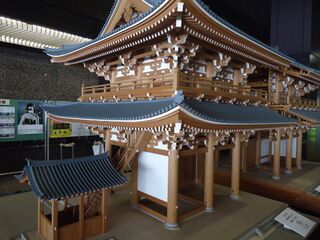Difference between revisions of "Tofuku-ji"
From SamuraiWiki
Jump to navigationJump to search (Created page with "*''Founded: 1236, Kujô family'' *''Japanese'': 東福寺 ''(toufuku-ji)'' Tôfuku-ji is a major Rinzai Zen temple in eastern Kyoto, founded i...") |
|||
| Line 1: | Line 1: | ||
| + | [[File:Tofukuji-model.JPG|right|thumb|320px|A 1/10th scale model of the temple's main gate, at the [[National Museum of Japanese History]] in [[Chiba prefecture]]]] | ||
*''Founded: [[1236]], [[Kujo family|Kujô family]]'' | *''Founded: [[1236]], [[Kujo family|Kujô family]]'' | ||
*''Japanese'': 東福寺 ''(toufuku-ji)'' | *''Japanese'': 東福寺 ''(toufuku-ji)'' | ||
Tôfuku-ji is a major [[Rinzai]] [[Zen]] temple in eastern [[Kyoto]], founded in [[1236]] by the [[Kujo family|Kujô family]]. | Tôfuku-ji is a major [[Rinzai]] [[Zen]] temple in eastern [[Kyoto]], founded in [[1236]] by the [[Kujo family|Kujô family]]. | ||
| + | |||
| + | The main gate of the temple, dating in its latest reconstruction to [[1425]], has been designated a [[National Treasure]]. The two-story gate is five bays wide, with three doors and ladders on either end leading up into the second story. Though fundamentally a ''wayô'' ("Japanese-style") structure, the gate features elements of ''daibutsuyô'' ("Great Buddha Style") and [[Zen architecture]].<ref>Gallery labels, National Museum of Japanese History.</ref> | ||
{{stub}} | {{stub}} | ||
| Line 8: | Line 11: | ||
==References== | ==References== | ||
*Amino Yoshihiko, Alan Christy (trans.), ''Rethinking Japanese History'', Center for Japanese Studies, University of Michigan (2012), 147n5. | *Amino Yoshihiko, Alan Christy (trans.), ''Rethinking Japanese History'', Center for Japanese Studies, University of Michigan (2012), 147n5. | ||
| + | <references/> | ||
[[Category:Temples]] | [[Category:Temples]] | ||
[[Category:Kamakura Period]] | [[Category:Kamakura Period]] | ||
Revision as of 18:40, 26 December 2014

A 1/10th scale model of the temple's main gate, at the National Museum of Japanese History in Chiba prefecture
- Founded: 1236, Kujô family
- Japanese: 東福寺 (toufuku-ji)
Tôfuku-ji is a major Rinzai Zen temple in eastern Kyoto, founded in 1236 by the Kujô family.
The main gate of the temple, dating in its latest reconstruction to 1425, has been designated a National Treasure. The two-story gate is five bays wide, with three doors and ladders on either end leading up into the second story. Though fundamentally a wayô ("Japanese-style") structure, the gate features elements of daibutsuyô ("Great Buddha Style") and Zen architecture.[1]
References
- Amino Yoshihiko, Alan Christy (trans.), Rethinking Japanese History, Center for Japanese Studies, University of Michigan (2012), 147n5.
- ↑ Gallery labels, National Museum of Japanese History.